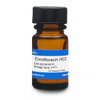Enrofloxacin Hydrochoride is the hydrochloride salt of Enrofloxacin, is a synthetic fluoroquinolone antibiotic modified from the quinolone family. It is commonly used in veterinary research and fish and poultry research applications. It is a broad-spectrum antibiotic that targets both Gram-positive and Gram-negative bacteria and a few Mycoplasma species. Its bacterical action is dependent on concentration. Its active metabolite is ciprofloxacin, which is arrived at via deethylation by CYP450. The compound can be used as a reference standard to determine the presence of Enrofloxacin in food samples. It can also be used in bacterial genetics, and also to understand the mode of action of fluoroquinolones. Enrofloxacin Hydrochloride is freely soluble in water.
We also offer:
- Enrofloxacin (E016)
| Mechanism of Action | Fluoroquinolone antibiotics target bacterial DNA gyrase, an enzyme which reduces DNA strain during replication. Because DNA gyrase is required during DNA replication, subsequent DNA synthesis and ultimately cell division is inhibited. It also inhibits topoisomerase IV enzyme. |
| Spectrum | Enrofloxacin is a broad-spectrum antibiotic targeting a wide variety of Gram-positive and Gram- negative bacteria and a few Mycoplasma species. It is ineffective against anaerobic bacteria. |
| Impurity Profile | Impurity A| 7-chloro-1-cyclopropyl-6-fluoro-4-oxo-1,4-dihydroquinoline-3-carboxylic acid|||| Impurity B| ciprofloxacin|||| Impurity C| 1-cyclopropyl-7-(4-ethylpiperazin-1-yl)-4-oxo-1,4-dihydroquinoline-3-carboxylic acid|||| Impurity E| 6-chloro-1-cyclopropyl-7-(4-ethylpiperazin-1-yl)-4-oxo-1,4-dihydroquinoline-3-carboxylic acid|||| Impurity F| 1-cyclopropyl-7-(4-ethylpiperazin-1-yl)-6-fluoroquinolin-4(1H)-one|||| Impurity G| 7-[(2-aminoethyl)amino]-1-cyclopropyl-6-fluoro-4-oxo-1,4-dihydroquinoline-3-carboxylic acid|||| |
| Microbiology Applications |
Enrofloxacin is commonly used in clinical in vitro microbiological antimicrobial susceptibility tests (panels, discs, and MIC strips) against Gram-positive, Gram-negative, and certain Mycoplasma species. Medical microbiologists use AST results to recommend antibiotic treatment options. Representative MIC values include:
Enrofloxacin can be found in aquatic environments due to aquaculture runoff since it is not completely metabolized by the fish. The high half-life and polar nature results in persistence in sediment, and can escape from photolysis. This can lead to high selective pressure to water microbes and activate the Enrofloxacin-resistant bacteria in the enironment which can impact human safety. Enrofloxacin resistance mechanisms include chromosomal alterations, higher expression of efflux pumps, and plasmid-mediated resistance genes (Emara et al, 2023). |
| Molecular Formula | C19H22FN3O3 •HCl |
| References |
Poller et al. used Enrofloxacin HCl (TOKU-E) to study "Influence of different surface chemistries on the ultrasensitive on-chip detection of enrofloxacin in milk" Feng X (2024) The enrofloxacin pollution control from fish to environment. Marine Pollution Bulletin 199: 115923 Gelatt KN et al (2001) Enrofloxacin-associated retinal degeneration in cats. Vet. Ophthalmol. 4(2):99-106 PMID 11422990 Wolfson JS Hooper DC (1985) "The Fluoroquinolones: Structures, mechanisms of action and resistance, and spectra of activity in vitro." Am. Soc. Microbiol. 4th ser. 28:581-586 |
| MIC | Aeromonas hydrophila| 0.06 - >0.4 | Aeromonas salmonicida subsp. salmonicida| 0.0047 - 0.06 | Burkholderia mallei| 2 - 4| Enterococcus| 0.5 - 8 | Enterococcus faecalis| 0.39 - 25 | Enterococcus faecium| 0.05 - 12.5 | Enterococcus hirae| 0.2 - 6.25 | Escherichia coli| 0.008 - 512 | Haemophilus parasuis| 0.12 - 8 | Lactobacillus acidophilus| 16 - 128 | Lactobacillus buchneri | 8 - 16| Lactobacillus plantarum| 0.125 - 16 | Lactobacillus reuteri| 4 - 32| Lactobacillus rhamnosus| 4 - 8| Lactobacillus salivarius | 4 - 16| Lactococcus | 0.5 - 8 | Leuconostoc | 0.5 - 8 | Mannheimia haemolytica| 0.007 - 0.125 | Mycoplasma bovis| 0.06 - 2 | Mycoplasma fermentans| <0.49 | Mycoplasma gallisepticum| 0.01 - >32 | Mycoplasma hyopneumoniae| 0.015 - >1 | Mycoplasma hyorhinis| 1.95| Mycoplasma hyosynoviae| 0.05 - 0.5 | Mycoplasma iowae| 0.03 - 1 | Mycoplasma meleagridis| 0.015 - 3.13 | Mycoplasma synoviae | 0.025 - >32 | Pasteurella haemolytica| 0.03| Pasteurella multocida| 0.00375 - 0.125 | Pediococcus | 0.5 - 8 | Pseudomonas aeruginosa| 0.5 - 2 | Rhodococcus equi| 0.03 - >4 | Salmonella typhimurium| 0.03| Staphylococcus| ≤0.25 - 2 | Staphylococcus aureus| 0.0925 - 64 | Staphylococcus intermedius| 0.03 - 0.25 | Streptococcus bovis| 1 - 16| Streptococcus infantarius | 1 - 16| Weissella spp.| 1 - 16| |








